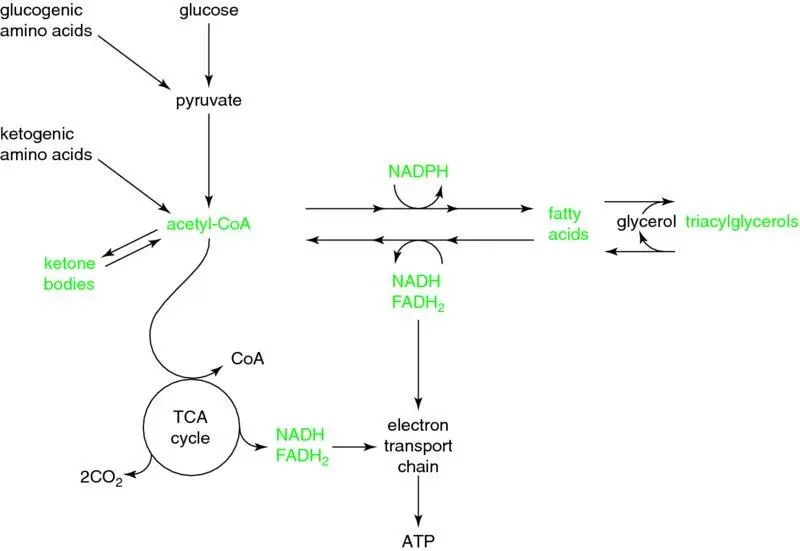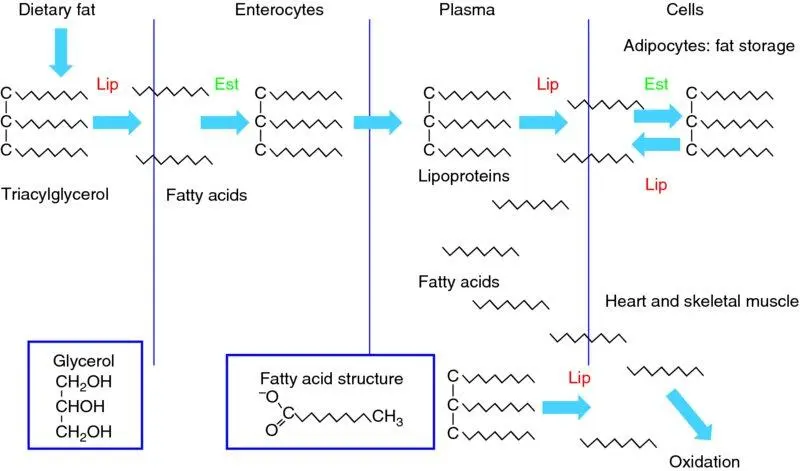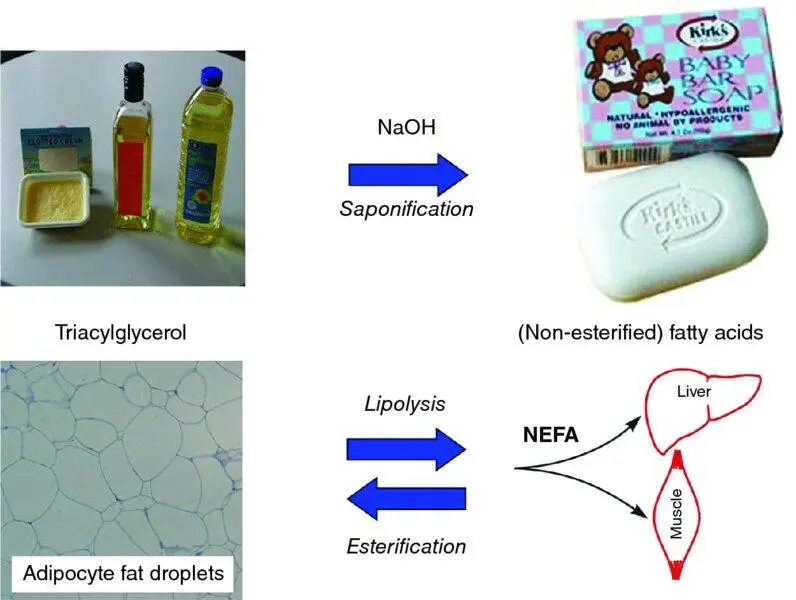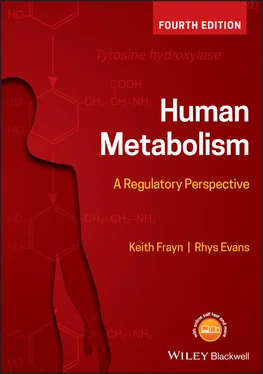
Figure 1.16 Pathways of lipid metabolism in the cell. Synthesis of fatty acids from acetyl-CoA (lipogenesis) is driven by NADPH (from the pentose phosphate pathway), whilst the opposite pathway, breakdown of fatty acids to form acetyl-CoA (β-oxidation) also produces NADH (and FADH 2). Esterification of fatty acids to glycerol produces triacylglycerols; the glycerol is released when the triacylglycerol undergoes lipolysis. Hence triacylglycerols are ‘storage’ forms of acetyl-CoA. Acetyl-CoA can be transported in the form of ketone bodies.

Figure 1.17 Lipid metabolism pathways. Importance of lipolysis and esterification pathways in lipid metabolism. Dietary fat, in the form of triacylglycerol, is hydrolysed in the intestinal lumen by pancreatic lipase and the products taken up into enterocytes (more detail in Section 4.2.3.2.3). Within the enterocytes, the fatty acids are re-esterified to glycerol [in fact some are taken up as monoacylglycerols and this is the basis for esterification – see Section 4.3.3]. The triacylglycerol is exported into plasma in the form of large lipoprotein droplets, the chylomicrons. Lipolysis of this circulating triacylglycerol by a lipase bound to endothelial cells (lipoprotein lipase) allows fatty acids to be taken up into cells for further esterification (adipose tissue) or for oxidation (muscle and other tissues). Triacylglycerol stored in adipocytes may be hydrolysed by intracellular lipases (further details in Chapter 5, Figure 5.10) to release fatty acids, which can travel through plasma for delivery to other tissues for oxidation. Most tissues also contain smaller amounts of triacylglycerol, formed by esterification of incoming fatty acids. Lip, lipolysis step; Est, esterification step. Structures are shown very diagrammatically. Fatty acids are represented by short wavy lines (more detail in box) but see Figures 1.4and 1.9for more detail.
Fatty acids are the lipids utilised for energy production in oxidative tissues; however, since they are amphipathic and detergent-like ( Figure 1.4) they are potentially toxic, and are stored as triacylglycerol, mainly in specialised cells known as adipocytes. Unlike carbohydrates such as glucose, lipids are (by definition) not water-soluble. As discussed in Figure 1.4, triacylglycerol is very hydrophobic, making it a very dense and efficient energy store. Whilst this is an advantage for energy storage, it necessitates specialised forms of intracellular storage and mechanisms for transport through the plasma.
Triacylglycerol within cells is stored in the form of lipid droplets , discrete droplets each bounded – and stabilised – by a monolayer of phospholipids, together with some specific proteins (described in more detail later, Box 5.7). This phospholipid coat is similar to the structure of a cell membrane shown in Figure 1.5, but with just the outer layer of phospholipids. In specialised cells for fat storage, adipocytes, there may be just one large lipid droplet, occupying much of the volume of the cell (and discussed in more detail in Chapter 5), but in most cells there are multiple, small lipid droplets.
Plasma fatty acids themselves, not esterified to glycerol, are known as NEFAs, sometimes called free fatty acids (FFAs). In plasma they are mainly bound loosely and non-specifically to the plasma protein albumin. They dissociate from albumin to enter cells. Triacylglycerol is also transported in plasma, usually along with cholesterol. This is achieved by formation of sub-microscopic lipid droplets in which a core of triacylglycerol is stabilised in the aqueous environment of the plasma by a surface monolayer of phospholipids, like intracellular lipid droplets. These droplets, or particles as they are often known, are associated with specific proteins to guide them round the circulation. The whole particle is then known as a lipoprotein . Lipoprotein metabolism will be discussed extensively in Chapter 10. Here we will briefly mention two relevant classes of lipoprotein particles: the chylomicrons and the very-low-density lipoproteins (VLDLs) – the reasons for these names will be explained in Chapter 10.
The reactions involved in interconversion of fatty acids and triacylglycerol are central to lipid metabolism. As shown in Figure 1.4, triacylglycerols consist of three fatty acid molecules esterified to one of glycerol (a trihydric alcohol, CH 2OH-CHOH-CH 2OH). These ester bonds are hydrolysed by lipase enzymes. There are several families of lipases, which will be mentioned where relevant in the text. The reaction is identical to that used in the manufacture of soap, known as saponification . In soap manufacture, a triacylglycerol (usually of vegetable oil origin) is treated with caustic soda (NaOH), resulting in the hydrolysis of ester bonds and the liberation of glycerol and fatty acids (in the form of their sodium salts). In metabolism, however, the hydrolysis is achieved by lipase enzymes ( Figure 1.18).

Figure 1.18 Parallel between soap manufacture (saponification) and fat mobilisation. In saponification, an alkali (usually NaOH) is used to hydrolyse a source of triacylglycerol – animal fat or a vegetable oil. The resultant sodium salts of fatty acids (together with glycerol) constitute soap. The hydrolysis of triacylglycerol stored in adipocytes is similar, but brought about by enzymes (more details in Chapter 5, Figure 5.10), and releases non-esterified fatty acids (NEFA) that may be used as a fuel in other tissues. However, in metabolism, unlike in soap manufacture, the process is reversible: fatty acids can also be re-esterified with glycerol to make new triacylglycerols (pathways are given in Chapter 4, Figure 4.8). This is the basis of the pathway by which triacylglycerol is laid down in adipocytes.
Unlike the relationship between vegetable oils and soap, however, in metabolism the process can be reversed: fatty acids can be re-esterified with glycerol to make new triacylglycerol. (The reaction usually uses glycerol 3-phosphate and will be described further in Chapter 5.) The fatty acids are added in the form of their coenzyme A esters, known as fatty acyl-CoA (i.e. fatty acid-CoA). (Note that fatty acyl-CoA is different from acetyl-CoA, although acetyl-CoA could be considered the simplest of the family of acyl-CoAs.)
1.3.3.2 Fat deposition and mobilisation
Most dietary fat is in the form of triacylglycerol (Table 4.1). Within the small intestine, dietary triacylglycerol molecules are hydrolysed by intestinal lipases and the products are absorbed into the cells lining the intestines ( mucosal or epithelial cells, collectively known as enterocytes ). The products of lipolysis are recombined with the enterocytes to form new triacylglycerol. These triacylglycerols, composed of dietary fat, are liberated into the circulation as lipoprotein particles: in fact, the largest and most fat-enriched of the lipoprotein particles, known as chylomicrons (more detail in Chapters 4and 10). At target tissues, the triacylglycerol in the lipoprotein particles is hydrolysed by a lipase bound to the endothelial cells lining the capillaries, known as lipoprotein lipase . The resulting fatty acids are taken up by cells, and have two potential fates: (i) re-esterification with glycerol 3-phosphate to make new triacylglycerol (and other lipids) – the pathway of fat deposition ; or (ii) oxidation. The former is the major route by which dietary fat is laid down for storage in adipose tissue ( Figure 1.17; Section 5.2.2.1).
Читать дальше















